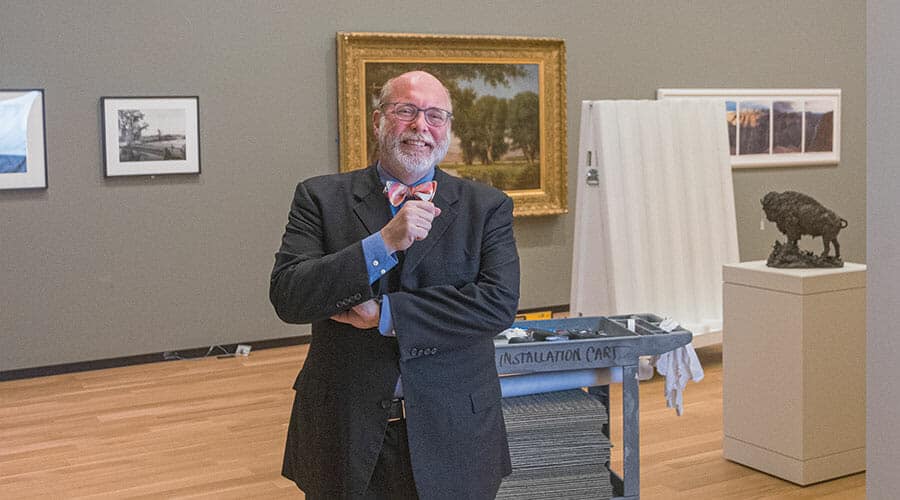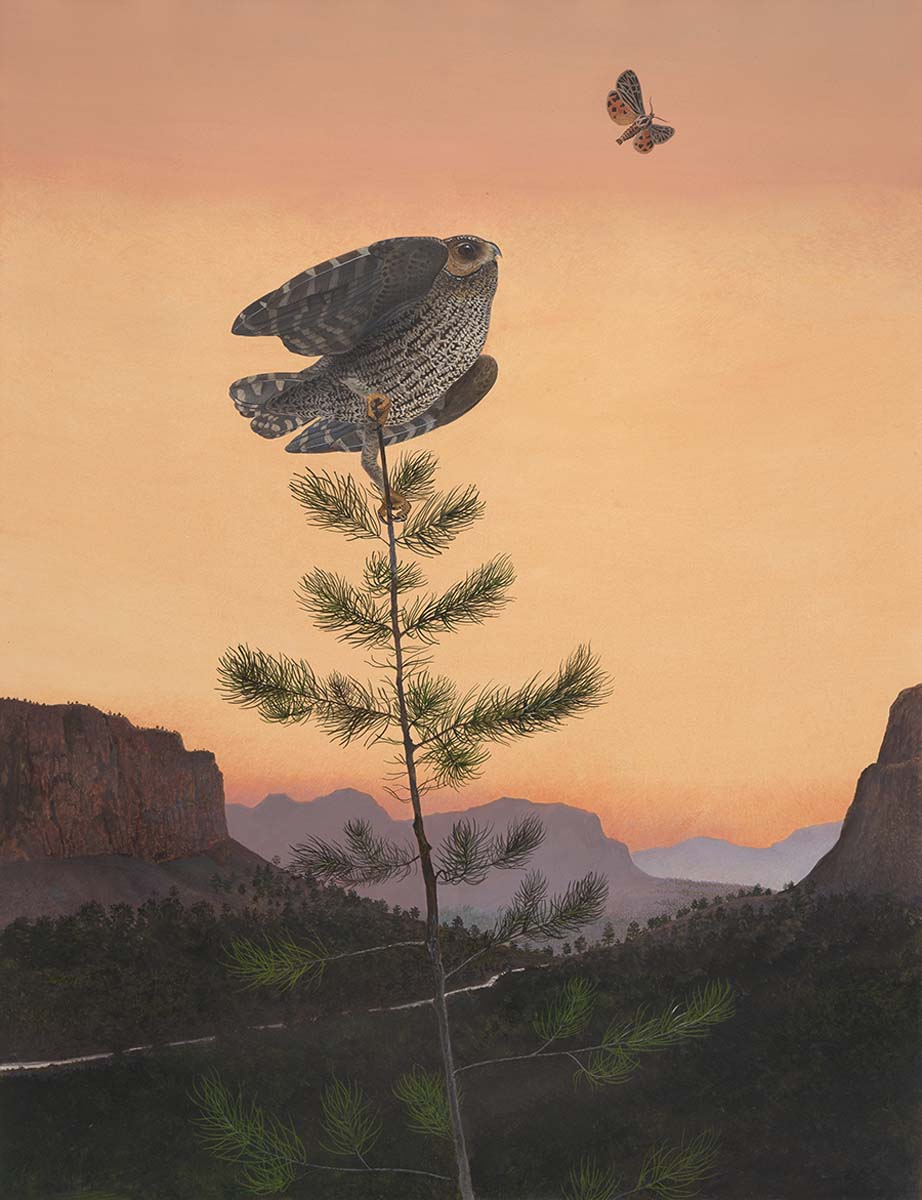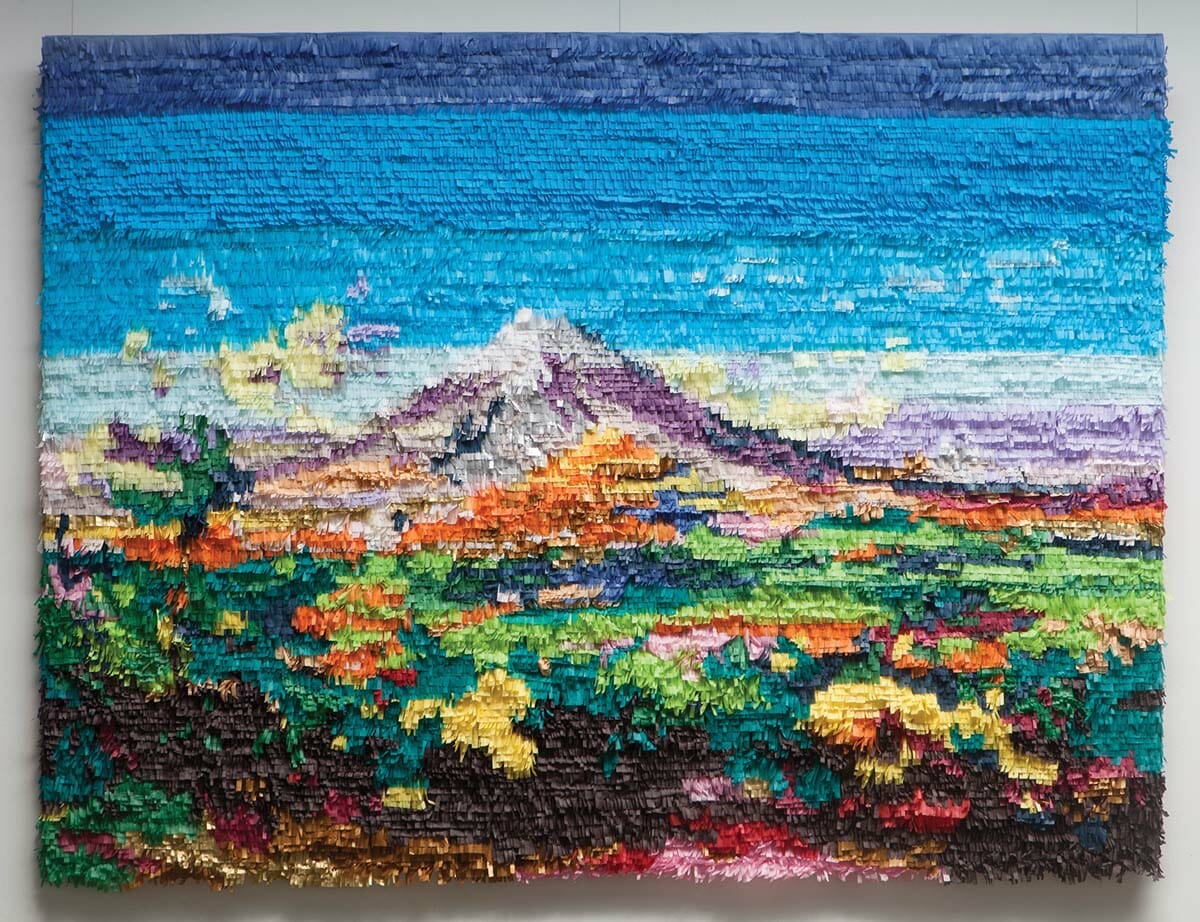
By Laura Samuel Meyn
By Jeremy Enlow
There’s a reason this man is smiling. The Amon Carter Museum of American Art wraps up a yearlong renovation that creates a worthy showcase for its collection and an inviting space for visitors.
For a year, the Amon Carter Museum of American Art has been under renovation. At first the work was quiet and behind the scenes; more recently, the place has been swarmed by construction crews, surrounded by a chain-link fence and closed to the public. Come September, stepping into the Amon Carter will be a new experience, and a welcome one, judging by the sneak peek we got in July. It’s not the first makeover for the museum. Designed in 1961 by the late architect Philip Johnson, it saw significant additions in 1964, 1977 and 2001.
The latest project is a game changer for an institution that has become more dynamic in recent years. The renovations provide a fitting new backdrop for not only the popular Western art but the museum’s collection of paintings, sculpture and works on paper and its 45,000 exhibition-quality photographs.
“The Amon Carter Museum of American Art has one of the top collections of American photography in the country. Many of our visitors, both near and far, do not realize this fact. This collection is truly a national treasure,” says director Andrew Walker. “Now, with this renovation, aspects of the photography collection will be featured year-round.”
It’s how the collections are exhibited along with the new look that gives the Amon Carter a fresh feel. Just steps inside, a wood-and-steel sculpture from Texas-born sculptor James Surls is suspended from the vaulted ceiling. “It’s going to have a great impact,” says Brett Abbott, director of collections and exhibitions. “We really like the idea of you walking into the building and encountering art immediately.”
The entry’s once cubby galleries now flow as a continuous space to house Amon G. Carter’s original collection of Frederic Remington and Charles M. Russell works. The ethereal rainbowlike thread sculpture by Gabriel Dawe, Plexus no. 34, remains on view, spanning the atrium. “We found having really relevant works by living artists that resonate and connect with our historical collection was a powerful experience in the museum,” says Abbott.
The permanent collection galleries upstairs now have wide-plank white oak floors, replacing worn carpeting that had long seemed too lowly for the works hanging on the walls — paintings by Winslow Homer, Arthur Dove, Georgia O’Keeffe, now arranged thematically instead of chronologically. Among transformative changes is the replacing of a flat black ceiling with a white coffered one with an LED system designed to mimic skylights and an expanded special exhibitions gallery.
The exterior also received a makeover. A redesigned entry features artfully integrated ramps that snake through new landscaping, adding accessibility through the front entrance. The expansive museum “porch,” with its stellar view east over the grassy terrace toward downtown, remains.
The yearlong renovation was executed with an eye toward the museum’s future. It began humbly, with the curatorial team simply proposing to reinstall the permanent collection. “That initiative led to a bigger consideration — to reconceive the way in which our guests to the museum experience the collection,” says Walker.
Abbott adds that a major focus was to make more efficient use of existing spaces to accommodate a collection that has increased by more than 4,400 objects since 2001. “The collection expanded dramatically, but all that expansion was shoehorned into the existing physical structure. The walls were not conceived to hold the work the way it was being hung,” he says. “Then you had areas like the mezzanine and main gallery almost vacant, inefficiently used. It became a moment where we could invest in the institution.”
While the latest renovation stayed within the building’s footprint, it smartly picked up 4,000 square feet of permanent collection gallery space, 3,000 square feet of special exhibition gallery space and 1,600 square feet of climate-controlled photography storage. Abbott says that among the paintings and sculpture, expect to see works on paper and photography from deep in the collection rotate in regularly — such pieces are light-sensitive and can’t be left out for too long. For visitors, that’s one of many reasons to stop in frequently.
The extra space for special exhibitions solves the museum’s problem of having to forgo or heavily edit traveling shows. While such galleries often see the construction and tear down of walls, the Amon Carter has installed a proprietary modular wall system with 8-foot sections that pull apart and move as needed; a wire hidden at the base can “zip” up to quickly separate them. “We will reuse these walls over and over again — just tape and repaint,” says Abbott. “The waste goes away; everything about this renovation is about honoring the past while looking to the future.
“One of the things that makes this so exciting is that this is institutional; there is a new curatorial program, a new physical experience, a new education apparatus — it’s all been conceived together to improve the visitor experience. It’s taking the museum to a new level of excellence. We have an incredible collection; it will sing off the walls as never before.”
THE DETAILS
Amon Carter Museum of American Art The museum reopens to the public at 10 a.m. Sept. 14, but museum members can visit Sept. 3-13 for a preview. 3501 Camp Bowie Blvd., Fort Worth, 817-738-1933 or cartermuseum.org.
Special events
Carter Happy Hour Museum staff host adult art activities: 5-8 p.m. Aug. 22 at Cowtown Brewing Co. and 5-8 p.m. Aug. 29 at World of Beer. Call 817-898-5013 or email education@cartermuseum.org for more information.
Party on the Porch The museum celebrates its reopening with the fifth annual free music and arts festival. The schedule includes tours of the new exhibitions and permanent collection galleries, art-making activities, food trucks and music from DJ Ronnie Heart, Abraham Alexander and The Band of Heathens.
New exhibitions
Gordon Parks: The New Tide, Early Work 1940-1950 Images by the pioneering African-American photographer, through Dec. 29.
James Surls’ Seven and Seven Flower A pine and steel sculpture, through July 31, 2020.
Set in Motion: Camille Utterback and Art That Moves An interactive installation using visitors’ movements to change an animated digital painting, through Dec. 8.
Seeing in Detail: Scott and Stuart Gentling’s Birds of Texas Extraordinary watercolors of birds by Fort Worth’s late twin brothers and artists, through Dec. 1.
Puente Nuevo by Justin Favela Vibrant murals inspired by the museum’s collection and made with tissue paper; members will be able to witness the installation during preview days, through June 30, 2020.



